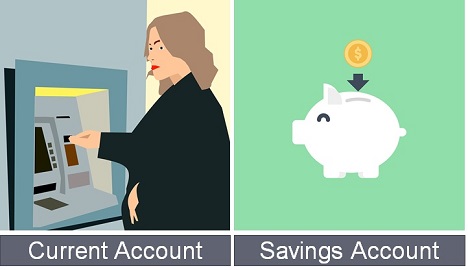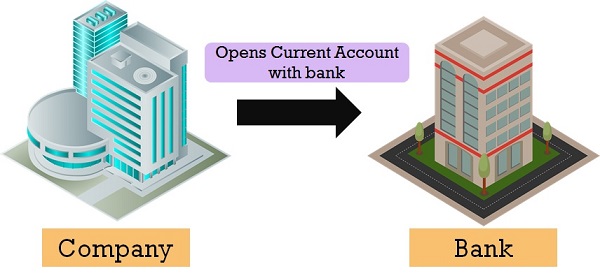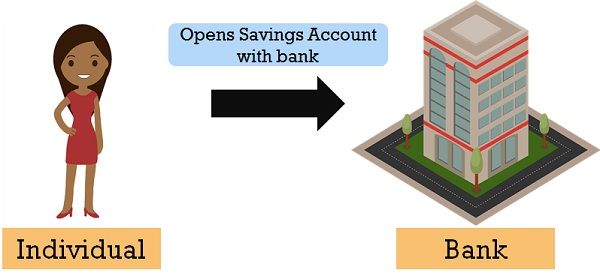 We are all acquainted with banking terms, as we encounter them almost daily, especially after digitalization. Savings Account is one such account, that we all have. We use this account to save our money for the long term and earn a fixed rate of interest. On the other hand, there is a current account that corporates open with the purpose of performing frequent transactions.
We are all acquainted with banking terms, as we encounter them almost daily, especially after digitalization. Savings Account is one such account, that we all have. We use this account to save our money for the long term and earn a fixed rate of interest. On the other hand, there is a current account that corporates open with the purpose of performing frequent transactions.
Now, you must be wondering – Why do we need to open a current account to perform transactions, when we can perform them with a savings account also?
Well, with a savings account there is a limitation that you can perform only a few withdrawal transactions in a month.
Suppose your banker allows you to perform a maximum of 4 withdrawals in a month. In such a situation, if your limit is over, then you have to pay an extra sum to perform the transaction in the name of the fee. While in the case of the current account, there is no such ceiling on the maximum number of withdrawal transactions.
What is a Bank Account?
A bank account refers to the financial account that a person or company has with the banking company. This facility allows customers to park the funds safely. And as an intermediary, the bank channelizes the funds to productive uses, which customers deposits.
It records all the financial transactions between the customer and the bank. Further, it shows the financial position of the account holder.
This post talks about the difference between savings account and current account.
Content: Current Account Vs Saving Account
- Comparison Chart
- What is a Current Account?
- What is Savings Account?
- Key Differences
- Video
- Similarities
- Conclusion
Comparison Chart
| Basis for Difference | Saving Account | Current Account |
|---|---|---|
| Meaning | Savings Account refers to a demand deposit account that an individual can open with a bank to manage their savings. | Current Account implies a transaction account that a firm can open with a bank to manage its business transactions. |
| Opened by | Individuals who would like to save money. | Business persons who perform regular and frequent business transactions. |
| Number of withdrawals | Limited number of withdrawals are allowed in a month. After the limit is over, the customer is charged a certain fee for every additional transaction. | No limit on the number of withdrawals. |
| Overdraft facility | Not Available | Available |
| Objective | To encourage savings and build emergency funds for the future. | To enable regular and frequent business transactions. |
| Payment of interest | Up to 3-4% | No interest is paid |
| Ideal for | An individual who gets a regular income like salaried people. Also, people who have any short-term goal to fulfil can also choose this account. | Those who perform frequent money transactions such as businessmen, firms, partnerships, public enterprises, etc. |
| Required Balance | Low minimum balance is required | High minimum balance is required |
What is a Current Account?
A current account offers easy access to your funds, as it allows seamless business transactions. It is a demand deposit account facility that banks provide to those who require liquid balance i.e. business persons, cooperative bodies, institutions or companies. Customers can opt for the facility of debit cards and cheque book to perform transactions.
It is primarily designed to facilitate transaction settlement by way of cheques. And that is why it is also known as a Checking Account.
The bank account allows them to perform frequent transactions in connection to their business. The transactions include deposits, withdrawals, bill payments etc. on a daily basis. Hence, a current account holder can perform unlimited per-day transactions.
At present, the banks also offer various innovative investment avenues for deposits. These deposit accounts not only offer a better rate of interest but also provide a withdrawable facility.
Features of Current Account
- Firms, Limited Liability Partnerships, Companies, Sole Proprietorships, etc. can open this account.
- There are no restrictions on the number of transactions that can be performed. It allows unlimited deposits or withdrawals.
- Because it provides high liquidity to the account holder, it is a non-interest-bearing account.
- The account can be overdrawn, as it provides an overdraft facility.
- The holder has to maintain a higher minimum balance.
- To open a current account the customer needs to furnish KYC documents.
- The holder is required to maintain a pre-determined amount as a minimum balance. Now you guys must be thinking – what happens when a person fails to maintain a minimum balance in his account? Well in such a case, they have to pay a sum as a penalty. The customer does not need to pay the amount of the penalty separately. This is because the amount is deducted directly from the respective account.
- Because there is no fixed tenure, one can maintain the account for years.
Meaning of Overdraft
It is a facility provided by banks to current account holders, in which they can withdraw more money from their accounts than they are actually having. This is what we call overdrawing of the account.
Overdraft is a kind of unsecured loan that banks provide to the holders. Therefore, the account holder has to pay interest on the amount overdrawn. However, there is a pre-decided limit, beyond which a person is not allowed to withdraw funds or make payments.
What is Savings Account?
A savings account allows the holder to deposit and withdraw money at their convenience and earn interest on it. It is meant to provide a saving vehicle for individuals who would like to deposit their temporary surplus and achieve long-term goals, but at the same time enjoy liquidity. Further, a person can maintain a savings account for as long as the holder requires.
Hence, a savings account allows you to park your extra funds with the bank. In this way, an individual will keep their funds safe. It develops a quality of thrift among people, to use their money wisely and carefully.
It provides small but constant passive income in the form of interest. But the rate of interest paid on the savings account deposits is lower in comparison to time deposits. Time Deposits can be Fixed deposits and Recurring Deposits.
Features of Savings Account
- Generally, it provides an interest rate of up to 1-4%. Banks pay interest on the available balance in the account. The interest rate in a savings account is variable. The banks calculate interest on deposits on a monthly basis. However, banks credit the interest to the account on a quarterly basis.
- One can open an individual or joint savings account.
- Most banks need to maintain a minimum balance in his/her account to keep them operational. Non-maintenance of minimum balance in the account will be subject to penalty.
- Customers can opt for the facility of debit card in their account, upon the opening of the account. With this, they can avail the online banking services for performing transactions online and also get easy access to cash via ATMs. Further, they can also avail cheque facility which also provides easy access to money.
- There is a limit on the amount one can withdraw from a savings account in a day. And also there is a limit on the total withdrawals in a month. This means that if a person’s withdrawals are more than the limit prescribed, then he/she has to pay a definite sum as a penalty.
- The account holder would require to quote the reasons for cash deposit and withdrawal beyond the maximum daily limit.
Key Differences Between Current Account and Savings Account
The difference between savings account and current account can be drawn clearly on the following grounds:
- Savings Account is a kind of demand deposit account that individuals maintain with a bank to park their surplus funds and earn interest on the deposits. As against, the current account is a demand deposit account that a company opens with the bank to carry out financial transactions of the firm smoothly.
- Current Account is ideal for business persons, entrepreneurs and traders who perform a range of transactions on a daily basis. Also, it allows them to deposit large sums of money without quoting the reason. On the contrary, a savings account is appropriate for persons with regular salaries or incomes, who wish to save a part of it for their future.
- In the case of the current account, there is no upper ceiling on the number of withdrawal transactions that businesses can perform in a month. As against, in savings accounts, there is an upper ceiling on the number of withdrawal transactions that an individual can perform in a month.
- The overdraft facility is available in the current account. This means that the account holder can withdraw more money than the funds actually available in the account. Conversely, this facility is not available for savings account holders.
- The objective of savings accounts is to motivate people to save money and build wealth. As against, the objective of the current account is to enable regular and frequent transactions.
- Savings Account Holders can earn interest up to 3-4% on a quarterly basis. Conversely, Current Account Holders do not get any interest.
- Savings Account is best for individuals who get a regular income like salaried people. Also, people who have any short-term goals to fulfil can also choose this account. Conversely, the current account is best for those who undertake monetary transactions on a frequent basis such as businessmen, firms, partnerships, public enterprises, etc.
- Both the accounts require the maintenance of a minimum balance, but in the case of the savings account the minimum balance to be maintained is comparatively lower than the current account.
Does it attract penalty?
Well, yes, if the account holder fails to maintain the minimum balance in their account penalty is levied in both the cases.
Video: Savings Vs Current Account
Similarities
- Both fall under the category of deposit products.
- They are Demand Deposits – those deposits which the holder or depositor can withdraw at any time and for which there is no need of prior notice.
- Account opening requirements of both are the same.
- The minimum balance requirement in both cases varies from bank to bank.
Conclusion
By far, we have understood that savings account and current account serves different purposes and address different financial needs of the holder. You can choose either of the two depending on your needs, goals, and preferences.








Arun Sengupta says
Thank you so much for the comparison, This blog really helped to understand factual differences between the two 🙂
Thanx for sharing this.
tsewang says
thank you and good to know between saving and current account
@linet says
Thank you a lot for these distinctions it has really help me even in other areas of studying am really grateful
Minthuko says
Thanks for your information. HELP me a lot
foster says
Am now clear , this information has really helped me a lot in making a decision in my life.
john michael says
This blog is really helpful cus I’ve understood the difference
shraddha says
Thank you so much this blog information is really helpful for me.
GAURAV RAMRAKHYANI says
Very helpful. Thank You.
Arun says
Thank you, it as a real quick reference guide.
Jemmi says
good wrk!!!
Ganesh. A says
Really it was very useful to me… Thank you so much for all..
Vinod says
Informative
Surbhi S says
Thank you all the readers, for sharing your views and opinions with us, Keep reading and sharing.. 🙂
Catherine says
Thank you so much for the lesson now i do understand their differences.
pranavika prasannan says
It’s very useful. Thanks a lot
Ajay says
Excellent article. Keep posting
Vikram Padia says
This article Is very useful.
sujith says
thanku very much for this valuable information.
Surbhi S says
Glad to know that the article helped you. It’s our pleasure, keep sharing your views with us.. 🙂
Abdulajeej g says
Thank you very much for sharing this blog and it may helpful for all and we can able learn something new.
simba says
Thanks a lot for the useful information.
Simba says
This was an adequate guide for me to open a bank account. Thanks a lot and I recommend it to users who were like me before I read.
Bidemi Abiola says
Well detailed in definitions, comparisons and differences.
Thank you.
Pirthipal says
Very good information, what is minimum amount to open current account?
Surbhi S says
The minimum amount will depend on the bank in which you are going to open current account.
BWAMBALE RAYMON says
i have finally understood the difference, thanks alot.
Arun says
Thanks for sharing the informative article, I really like this post.
sitherens says
Nice article Thanks for sharing this informative post, Keep posting!